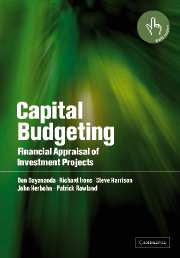Book contents
- Frontmatter
- Contents
- List of figures
- List of tables
- Preface
- 1 Capital budgeting: an overview
- 2 Project cash flows
- 3 Forecasting cash flows: quantitative techniques and routes
- 4 Forecasting cash flows: qualitative or judgemental techniques
- 5 Essential formulae in project appraisal
- 6 Project analysis under certainty
- 7 Project analysis under risk
- 8 Sensitivity and break-even analysis
- 9 Simulation concepts and methods
- 10 Case study in financial modelling and simulation of a forestry investment
- 11 Resource constraints and linear programming
- 12 More advanced linear programming concepts and methods
- 13 Financial modelling case study in forestry project evaluation
- 14 Property investment analysis
- 15 Forecasting and analysing risks in property investments
- 16 Multinational corporations and international project appraisal
- References
- Index
5 - Essential formulae in project appraisal
Published online by Cambridge University Press: 14 May 2010
- Frontmatter
- Contents
- List of figures
- List of tables
- Preface
- 1 Capital budgeting: an overview
- 2 Project cash flows
- 3 Forecasting cash flows: quantitative techniques and routes
- 4 Forecasting cash flows: qualitative or judgemental techniques
- 5 Essential formulae in project appraisal
- 6 Project analysis under certainty
- 7 Project analysis under risk
- 8 Sensitivity and break-even analysis
- 9 Simulation concepts and methods
- 10 Case study in financial modelling and simulation of a forestry investment
- 11 Resource constraints and linear programming
- 12 More advanced linear programming concepts and methods
- 13 Financial modelling case study in forestry project evaluation
- 14 Property investment analysis
- 15 Forecasting and analysing risks in property investments
- 16 Multinational corporations and international project appraisal
- References
- Index
Summary
One of the most important principles of finance is that money has a time value. In the most general sense this refers to the fact that a dollar today is worth more than a dollar in one year's time. One reason for this is that a dollar today can earn interest while waiting for one year. This means that a given sum of money (say a cash flow of $5,500) should be valued differently, depending on when the cash flow is to occur. If the interest rate is 10% per annum, the present value of $5,500 received at the end of the first year is $5,000. This is because, $5,000 today can be invested at 10% to earn $500 interest at the end of the year. If the $5,500 is received at the end of two years from today, its present value is smaller than $5,000; it is approximately $4,546.
Capital budgeting decisions deal with sizable investments in long-lived projects. As discussed in Chapter 2, the cash flows of a project are spread over many years. In many cases, large sums of money are invested in the first year and net operating cash flows are received over a number of years. At the termination of the project, terminal cash flows are realized. In addition to the initial investment in the first year of the project, capital expenditures may occur at later stages of the project, for example, upgrades to the plant and equipment.
- Type
- Chapter
- Information
- Capital BudgetingFinancial Appraisal of Investment Projects, pp. 74 - 90Publisher: Cambridge University PressPrint publication year: 2002



